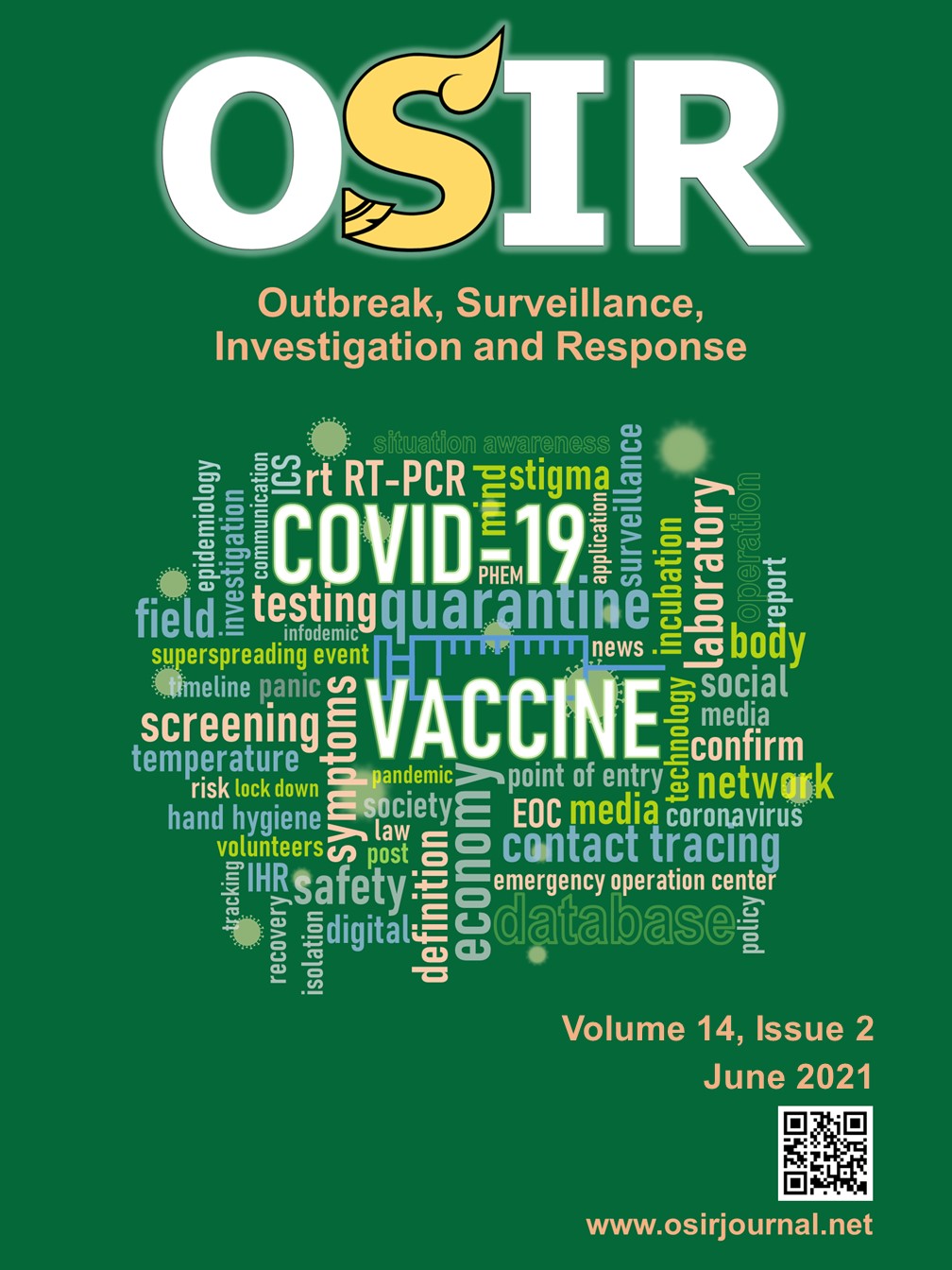Adverse Drug Reactions Associated with Dimenhydrinate, Thailand, 1993-2016
DOI:
https://doi.org/10.59096/osir.v14i2.262689Keywords:
dimenhydrinate, adverse drug reactions, severe drug-induced skin reactionsAbstract
In 1984, the Health Product Vigilance Center of Thailand was established and has continuously collected adverse drug reaction (ADR) reports across the country. Severe drug-induced skin reactions with dimenhydrinate can result in death in some cases. All ADRs with dimenhydrinate from 1 Jan 1993 to 31 Dec 2016 were reviewed. Characteristics and system organ class ADRs from 7,282 patients were described. Most patients had no history of allergy (77%) and no underlying disease (83%) and the majority were female (75%). Skin appendage ADRs were the most commonly reported (52%) events and 1,431 reports were severe skin ADRs, including bullous fixed drug eruption (89%) and Stevens-Johnson syndrome (9%). Among patients who received dimenhydrinate and had ADRs, 63% completely recovered and 0.18% died. Multivariate regression analysis revealed that patients aged more than 65 years or having a history of allergy were more likely to have a serious ADR than those in the other groups. Dimenhydrinate must be avoided or used with vigilance when prescribed to the elderly or patients with a history of allergy due to its seriousness.
References
Sriphiromya P, Theeraroungchaisri A. An analysis of legal warnings after drug approval in Thailand. Regul Toxicol Pharmacol. 2015;71(1):108-13.
Saokaew S, Suwankesawong W, Permsuwan U, Chaiyakunapruk N. Safety of herbal products in Thailand. Drug Saf. 2011;34(4):339-50.
Moore TJ, Cohen MR, Furberg CD. Serious adverse drug events reported to the Food and Drug Administration, 1998-2005. Arch Intern Med. 2007;167(16):1752-9.
Lacost‐Roussillon C, Pouyanne P, Haramburu F, Miremont G, Bégaud B. Incidence of serious adverse drug reactions in general practice: a prospective study. Clin Pharmacol Ther. 2001;69(6):458-62.
Lazarou J, Pomeranz BH, Corey PN. Incidence of adverse drug reactions in hospitalized patients. JAMA. 1998 Apr 15;279(15):1200-5.
Mockenhaupt M. Severe drug-induced skin reactions: clinical pattern, diagnostics and therapy. J Dtsch Dermatol Ges. 2009;7(2):142-62. English, German.
Intong LRA, Daniel BS, Murrell DF. Erythema Multiforme, Stevens-Johnson Syndrome, and Toxic Epidermal Necrolysis. In: Murrell D, editor. Blistering Diseases. Berlin: Springer; 2015. p. 319-26.
Barvaliya M, Sanmukhani J, Patel T, Paliwal N, Shah H, Tripathi C. Drug-induced Stevens-Johnson syndrome (SJS), toxic epidermal necrolysis (TEN), and SJS-TEN overlap: a multicentric retrospective study. J Postgrad Med. 2011;57(2):115-9.
Khan DA, Solensky R. Drug allergy. J Allergy Clin Immunol. 2010;125(2):S126-37.e1.
Mockenhaupt M, Schöpf E, editors. Epidemiology of drug-induced severe skin reactions. Semin Cutan Med Surg. 1996;15(4):236-43.
Ganeva M, Gancheva T, Lazarova R, Troeva J, Baldaranov I, Vassilev I, et al. Carbamazepininduced drug reaction with eosinophilia and systemic symptoms (DRESS) syndrome: report of four cases and brief review. Int J Dermal. 2008;47(8):853-60.
Hahn A, Sejna I, Stefflova B, Schwarz M, Baumann W. A fixed combination of cinnarizine/dimenhydrinate for the treatment of patients with acute vertigo due to vestibular disorders. Clin Drug Investig. 2008;28(2):89-99.
Shakouri AA, Bahna SL. Hypersensitivity to antihistamines. Allergy Asthma Proc. 2013 Nov-Dec;34(6):488-96.
Rajagopalan S, Kaur S, Dogra S, Shafiq N, Bhalla A, Pandhi P, et al. Toxic Epidermal Necrolysis induced by rarely implicated drugs. Indian J Pharmacol. 2012;44(2):272-3.
Bailey C, Peddie D, Wickham ME, Badke K, Small SS, Doyle‐Waters MM, et al. Adverse drug event reporting systems: a systematic review. Br J Clin Pharmacol. 2016;82(1):17-29.
Layton D, Shakir SA. Specialist cohort event monitoring studies: a new study method for risk management in pharmacovigilance. Drug Saf. 2015;38(2):153-63.
Doherty MJ. Algorithms for assessing the probability of an adverse drug reaction. Respiratory Medicine CME. 2009;2(2):63-7.
Naranjo CA, Busto U, Sellers EM, Sandor P, Ruiz I, Roberts E, et al. A method for estimating the probability of adverse drug reactions. Clin Pharmacol Ther. 1981;30(2):239-45.
Brewer T, Colditz GA. Postmarketing surveillance and adverse drug reactions: current perspectives and future needs. JAMA. 1999;281(9):824-9.
Craigle V. MedWatch: the FDA safety information and adverse event reporting program. J Med Libr Assoc. 2007;95(2):224-5.
Patel H, Bell D, Molokhia M, Srishanmuganathan J, Patel M, Car J, et al. Trends in hospital admissions for adverse drug reactions in England: analysis of national hospital episode statistics 1998–2005. BMC Clin Pharmacol. 2007;7(1):9.
Thiessard F, Roux E, Miremont-Salamé G, Fourrier-Réglat A, Haramburu F, Tubert-Bitter P, et al. Trends in spontaneous adverse drug reaction reports to the French Pharmacovigilance system (1986-2001). Drug Saf. 2005;28(8):731-40.
Sawanpanyalert P, Suwankesawong W. Health Products Vigilance in Thailand: Past, Present and Future. Journal of Health Science. 2016;25(3):444-55.
Feely J, Moriarty S, O'Connor P. Stimulating reporting of adverse drug reactions by using a fee. BMJ. 1990;300(6716):22-3.
Moore N, Lecointre D, Noblet C, Mabille M. Frequency and cost of serious adverse drug reactions in a department of general medicine. Br J Clin Pharmacol. 1998;45(3):301-8.
Lee CH, Chen YC, Cho YT, Chang CY, Chu CY. Fixed-drug eruption: A retrospective study in a single referral center in northern Taiwan. Dermatologica Sinica. 2012;30(1):11-5.
Cho YT, Lin JW, Chen YC, Chang CY, Hsiao CH, Chung WH, et al. Generalized bullous fixed drug eruption is distinct from Stevens-Johnson syndrome/toxic epidermal necrolysis by immunohistopathological features. J Am Acad Dermatol. 2014;70(3):539-48.
Saenz de San Pedro B, Quiralte J, Florido JF. Fixed drug eruption caused by dimenhydrinate. Allergy. 2000;55(3):297.
Stritzler C, Kopf AW. Fixed drug eruption caused by 8-chlorotheophylline in dramamine with clinical and histologic studies. J Invest Dermatol. 1960;34(5):319-30.
Hanlon JT, Pieper CF, Hajjar ER, Sloane RJ, Lindblad CI, Ruby CM, et al. Incidence and predictors of all and preventable adverse drug reactions in frail elderly persons after hospital stay. J Gerontol A Biol Sci Med Sci. 2006;61(5):511-5.
Zopf Y, Rabe C, Neubert A, Gassmann K, Rascher W, Hahn E, et al. Women encounter ADRs more often than do men. Eur J Clin Pharmacol. 2008;64(10):999-1004.
Thong BYH, Tan TC. Epidemiology and risk factors for drug allergy. Br J Clin Pharmacol. 2011;71(5):684-700.
Downloads
Published
How to Cite
Issue
Section
License
Copyright (c) 2023 Outbreak, Surveillance, Investigation & Response (OSIR) Journal

This work is licensed under a Creative Commons Attribution-NonCommercial-NoDerivatives 4.0 International License.









